Choice Canal Cities: Brugge and Amsterdam
Separated by just 100 miles, yet worlds apart in history, Brugge and Amsterdam are two of Europe’s most enjoyable cities. They are ideal to savor via bicycle, meandering walks, or boating along cozy waterways. Lively cafes and beer halls beckon after a day’s exploration. Come join us on a fun-filled visit! You’ll stay two days in both central Brugge and Amsterdam.
| Belgian Bonus The world is fortunate that Belgium’s medieval trading city of Brugge had the misfortune to dwindle when its harbor became silted in the 16th century, leaving the city unchanged for today’s visitors. The unique Gothic and Renaissance architecture, streets, and canals sit neatly within a 1-kilometer-square moat canal. A new port, Zeebrugge, brought renewed vitality to the area in the 1800s, and the ancient town of Brugge was restored to its beautifully preserved state. You’ll share Brugge with the other tourists, but this is one city where you won’t mind. |
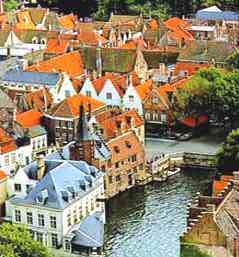 |
Day 1 — Brugge via canal and afoot
Get oriented to Brugge by starting with a 35-minute boat ride along the main canal, which bisects the old town. There are a number of boarding/debarking docks near the town center. The Dijyerstraat docks are most centrally located. The captain narrates the major sights as you slowly pass Brugge’s signature architecture with stepped-gable facades and colorful flower boxes lining the canals.
On debarking, amble north along the narrow streets to the bustling Markt, the ancient Market Square. Cafes line the square’s fringes, and the ancient Belfort (belfry tower) awaits your ascent of its 366 steps for an incredible city view. The 47-bell carillon chimes every quarter-hour, and concert pieces are played by the carillon at scheduled times throughout the week.
It’s a short stroll eastward to the opulent square called Burg, Brugge’s civic center and its 9th-century birthplace when the Count of Flanders constructed a castle here. Today the square preserves six centuries of architecture. In the southwest corner is the Romanesque Basilica of the Holy Blood. Dating from the 1100s, this church houses the relic of the blood of Christ, reportedly brought to Brugge in 1150 after the Second Crusade. As your view sweeps counterclockwise from the Basilica, you’ll see the Gothic Town Hall (1400s), the Renaissance Recorder’s House (1600s), and the Baroque Provost’s House (1700s).
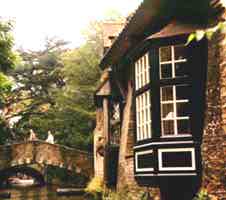 |
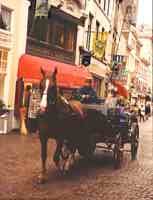 |
Stop for lunch at one of the nearby cafes before continuing on to the Groeninge Museum. The collection showcases Flemish Primitive art, with notable pre-Renaissance paintings by Memling, Magritte and other early masters. From the museum, walk a short distance to the Church of Our Lady, reflecting the power and wealth of Brugge in its heyday. It displays a delicate Michelangelo statue, titled Madonna and Child.
Day 2 — Brugge cycling
Now that you’ve enjoyed the major Brugge sights, its time to get lost on the back streets and experience the ambiance of Brugge and the surrounding countryside via bicycle. You’ll find shops around the Markt that rent good bicycles and provide detailed maps. The perfectly flat terrain invites leisurely peddling. Be sure to ride through the Beguinage, an old Brugge walled quarter where women of the medieval ages lived a safe life of piety and service without taking a nun’s lifetime vows. Ride the paths of the Minnewater park with its canals, swans, lawns, and flower beds. Then head out into the Belgium countryside, for a few miles along a canal to visit the medieval village of Damme. You can stop at a deli shop in town before picnicking at the cozy town square. When you return to Brugge, be sure to stop at the Straffe Hendrik Brewery to take a tour of their working family establishment and partake their world-renowned beer on the garden terrace. Give a toast to the two top-rate days you’ve enjoyed in Brugge.
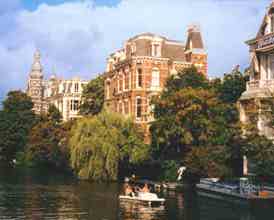 |
Dutch Treat — Arriving in Amsterdam Amsterdam was perfectly laid out in a circle of concentric, street-lined canals with spokes of interconnecting streets in the 1600s. The original five-story buildings and homes stand wall-to-wall, fronted by beautiful trees lining the canals and streets. Most of the major sights sit within one square mile, near the train station. This biker’s paradise sports an overall feeling of love for art, music, and life. Restaurants, bars, and cafes are filled with vibrant people. No wonder Amsterdam is at the top of the list for most European visitors. |
It’s a relatively short train hop of 3-1/2 hours from Brugge to Amsterdam. After arriving and getting settled, you’ll still have time to take the short walk to Anne Frank’s House. This museum has left Anne’s World War II hiding place from the Nazis perfectly intact. It is a moving experience to climb the narrow stairs and walk through the rooms.
Day 1 — Rembrandts, Boats, and Coffee
Join the crowd and jump into the joyful melee of bicycling Amsterdam. You can rent bicycles for a low fare at the train station (one-speed only) or at shops throughout the city (three-speed, in better condition). The bike’s double-locking system will allow you to leave them whenever you want. In lieu of bicycling, you can walk, and take Tram 20 that circles the city.
 |
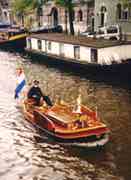 |
 |
Start your day early with a visit to one of Europe’s top museums, Rijksmuseum. Focus on the Dutch masters: Rembrandt, Hals, Vermeer, and Steen. The wonderful Dutch art reflects love of good living and eating. Right next door is the Van Gogh Museum, due to reopen June 23, 1999 after renovation. Next, pedal over to Dam Square, right at the center of Amsterdam, and home to the Royal Palace with its bell-tower carillon music concerts running each hour. Then, travel on to the markets at the area known as Spui, near Singel Canal. This is a great place to stop for lunch or coffee and enjoy the scenes at the nearby flower market.
In the afternoon take a canal boat tour where Spui meets Rokin. The 60-minute tour will circle through the major city canals, and includes a narration on the major sights, as well as a short tour through the harbor and back into the central city. Spend the rest of the afternoon enjoying bicycling along the canals and be sure to stop at Leidespein square for people watching with its street artists, musicians, and jugglers.
Day 2 — Coastal Towns and Countryside
Catch a 30-minute bus ride from the main train station into the countryside, north to the coastal villages of Vollendam and Edam. The bus makes return-trip cycles through these towns and back to Amsterdam approximately every hour. Walk the harbor promenade at Vollendam and explore the narrow streets stretching back into the town. On the day we visited in September we found ourselves smack in the middle of the annual festival, with friendly revelers who had been partying for two days running.
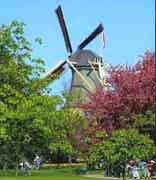 |
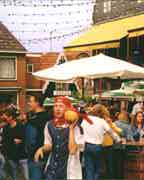 |
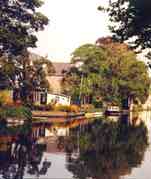 |
Catch the bus on to Edam and rent a bicycle to tour the cute village, the nearby countryside, and canals which head into the North Sea. This is bustle-free Holland, with flower boxes, small squares, old churches, and surrounding dairy farms. You’ll be able to return to Amsterdam in time for a hearty dinner and night on the town.
A Perfect Pairing
The proximity, history, and contrasts afforded by Belgium’s Brugge and Holland’s Amsterdam make them a perfect pairing for your travel itinerary in Europe’s Low Country. Within a short day’s travel of England, France, and Germany, these cities will greatly reward your travel efforts.
Click here for details to plan your own trip to Brugge and Amsterdam.
Les Furnanz
Photos: Rita Furnanz